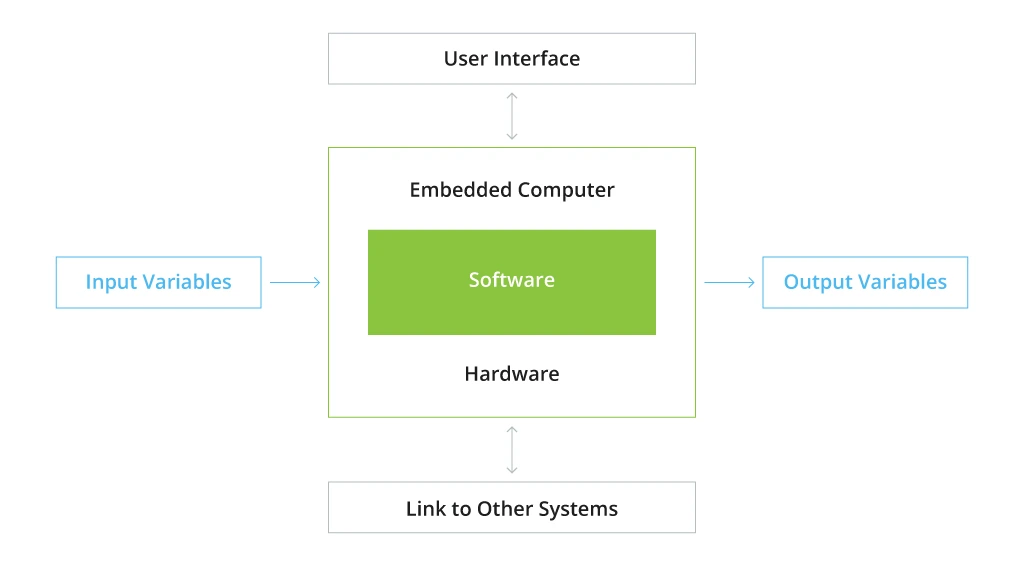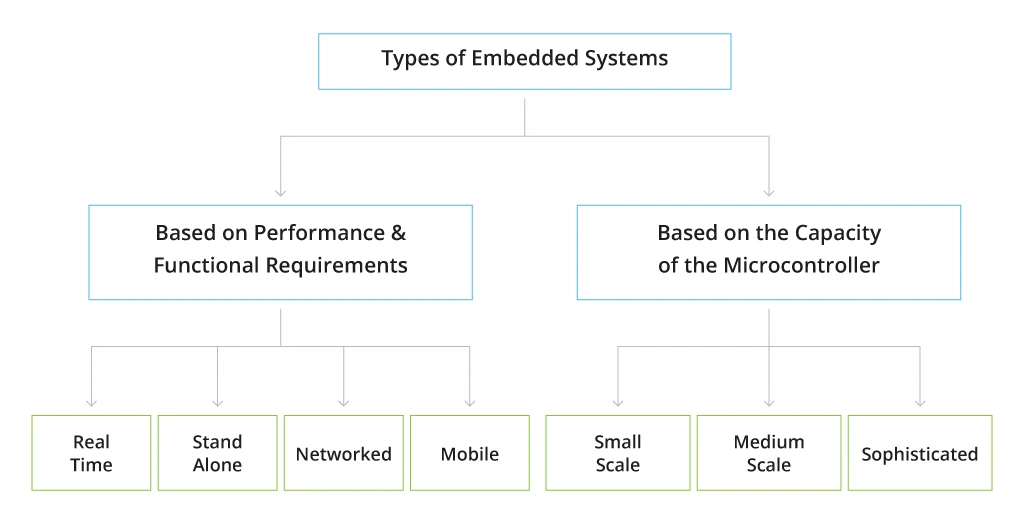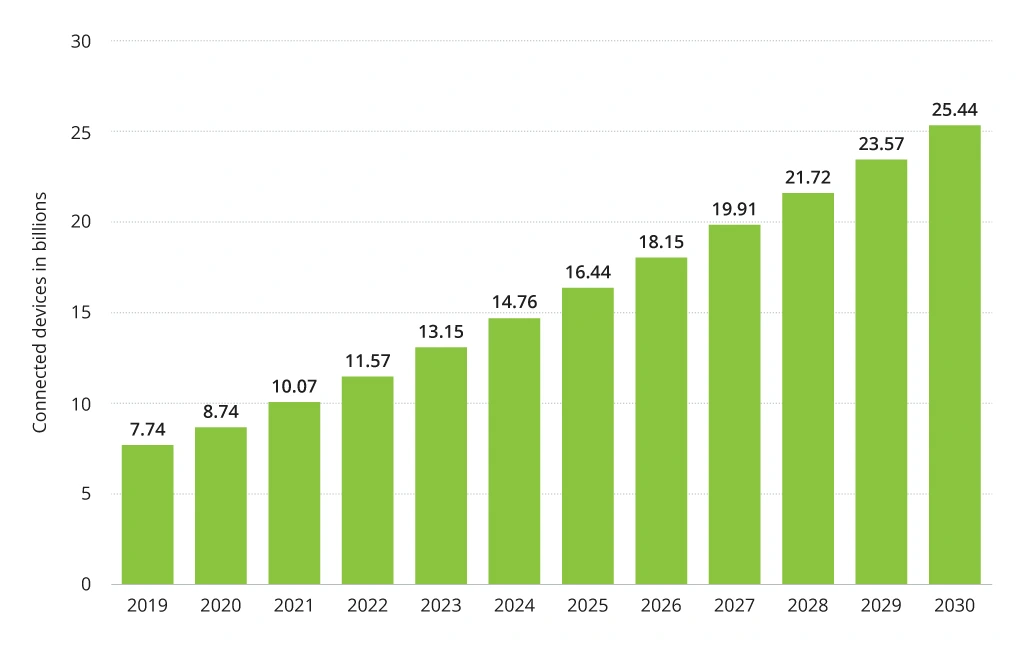Challenges and Issues of Embedded Software Development
Embedded software, often called firmware, permanently resides in its dedicated hardware creating a single embedded software. Our daily environment, whether at work or home, is full of embedded software. Every electronic device is capable of fulfilling “smart” functions only due to its native embedded software. The full range of computer peripherals like monitors, printers, routers, digital cameras, flesh memory sticks, headphones, etc. as well as household appliances like washing machines, microwave ovens, digital TVs, video cams, mobile phones, and so on at the core are all built around embedded software.
What Makes Embedded Software So Widely Used?
As we mentioned above, almost all devices surrounding us contain elements of embedded software not to mention such mission-critical applications as various industrial automation equipment, electronic control units and antilock brakes in cars or missile guidance systems. Sure, it refers to IoT devices too, now so fast gaining in popularity.
Embedded software are met practically in every industry, to name but a few: Automotive, Aerospace, Telecom, Consumer Electronics, Healthcare, Banking, Office and Home appliances, Security, etc.
What makes embedded software so special as compared to common application software? Well, the most critical features of embedded software is its greater reliability, accuracy, and performance speed enabling real-time computing. Besides, they have smaller size and lower power consumption, which opens for them a wider variety of applications.
Any device with some built-in digital interface that is supposed to perform computing belongs to embedded software. Such system can be implemented in a standalone device or as a part of a larger system it communicates with through Internet, Bluetooth, or other communication channels.
A Glance into History
Classical embedded software (very simple microcontrollers, logical circuit boards with triggers) was written in Assembler or in combination with C, using a toolkit for deployment. For decades, developers had to code from the scratch using low-level programming, in fact, creating a sort of an individual OS.
Later on, Real-Time Operating Systems (RTOS) appeared on the scene, which are still in use today. For a while, these were the only OS to use in embedded software solutions. They are still actual in life-critical and mission-critical systems, e.g. in circuit boards of surgery tools, circuit boards of missile guidance systems, or manufacture safety systems. Any sensor, any circuit board was required to provide immediate action in no time.
For mission-critical systems, classical embedded software programming in different modern and well-developed languages is not an option in principle due to potential delays in the system response, hence low-level programming is fundamental. Everything must act exactly according to the original engineering design. For example, a 50-ton pneumatic hammer must stop in an instant, when operator’s hand incidentally projects into the impact area.
Car manufacturers use real-time OS in Engine Control Units (ECU) due to both high reputational risk and national regulatory requirements. Same refers to autopilot and collision avoidance systems in planes too, which, though very expensive, are mandatory under international regulations.
Thus, real-time OS are the only solution in certain industrial areas. Some manufacturers still keep using them in infotainment systems, but the majority of developers switched to Linux programming for embedded software. As a result, this category of embedded software is written in C under Linux similar to desktop or server apps with the difference that Linux is launched on a small device. Such “make-believe” systems are no way real-time per se, but with the development of hardware, this situation is changing. Today, small devices have more capacity than servers had 15 years ago. We can expect the infotainment systems to move to Android and Java with the use of high-performance multi-core processing units capable of coping with the task.
Another specific category of firmware development we can see in low-energy devices used in IoT embedded software. The programming goes in C or Assembler, or other languages with a toolkit specifically designed for real-time systems like Micrium Wallet. Currently, frameworks like Azure IoT Hub allow deploying such software on any device, for instance, Arduino or Raspberry Pi.
Similar to Mobile Device Management, IoT Device Management is remote management of a big number of devices, e.g. in a workshop or logistics hub. Standard stack is Arduino or Raspberry Pi, plus Azure IoT Hub, which enables centralized management of all these devices. In case of devices like Arduino, a customized driver to any circuit board (microcontroller) has to be written with the use of standardized IoT protocol.
Composition of Embedded Software
Depending on the complexity of device, all embedded solutions use microcontrollers, microprocessors, or other special-purpose processing units like digital signal processors (DSP) at the heart of their dedicated hardware.
The common set of embedded software components is as follows:
- User interface;
- Input/output interfaces;
- Processor;
- Memory;
- Timers;
- Serial communication ports;
- Circuits to connect to other systems.
Basic Elements of an Embedded System

And, of course, a piece of specific embedded software to provide designed functionality. The system can be programmable or non-programmable depending on its purpose of use.
In terms of the requirements to system performance, functionality and capacity of microcontroller, there are several categories of embedded software. First four are based upon system performance/functionality requirements; the other three refer to microcontroller’s capacity.
Types of Embedded Systems: Balance between Functionality, Performance and Capacity

Challenges of Embedded Software Development
Embedded software is always a constituent of a larger system, for instance, a digital watch, a smartphone, a vehicle or automated industrial equipment. Such embedded solutions must have real-time response under all circumstances within the time specified by design and operate under the condition of limited memory, processing power and energy supply. Moreover, embedded software must be immune to changes in its operating environment – processors, sensors, and hardware components may change over time. Other challenging requirements to embedded software are portability and autonomy.
Challenge #1: Stability
Stability is of paramount importance. Unexpected behavior from an embedded software is inadmissible and poses serious risks. End users demand that embedded software must have uniform behavior under all circumstances and be able to operate durably without service.
Challenge #2: Safety
Safety is a special feature of embedded software due to their primary application associated with lifesaving functionality in critical environments. Software Development Life Cycle (SDLC) for embedded software is characterized by more strict requirements and limitations in terms of quality, testing, and engineering expertise.
Challenge #3: Security
Security became a burning issue in the digital world. The related risks grow exponentially, especially so for IoT devices gaining popularity worldwide and becoming more interconnected to each other. Because modern home appliances like electric cookers, refrigerators and washing machines have connectivity feature integrated by default, Internet of Things now is exposed to a serious risk of hacking attacks. For instance, the most pressing security concerns of 2020 were malware or ransome protection, financial losses and data theft as well as intellectual property infringement along with confidential informal leaks.
Challenge #4: Launch Phase
Time-to-market and time-to-revenue have always been tough indicators in embedded software development, especially in the IoT segment. That is why the apps and platforms supposed to support numerous IoT devices expected to reach 13.8 billion units in 2021 and surpass a 30-billion mark by 2025. Fabrication of hardware components housing embedded software requires extreme integration and flexibility due to very fast development of IoT industry. In addition, taking into account longer IoT device lifespan, future updates and releases become an issue for component designers.
Challenge #5: Design Limitations
The challenges in design of embedded software have always been in the same limiting requirements for decades:
- Small form factor;
- Low energy;
- Long-term stable performance without maintenance.
The market demands from designers to pack more processing power and longer battery life into smaller spaces, which is often a tradeoff. Finally, depending on applications in IoT, there is a growing demand for manufacture of very scalable processor families ranging from cheap and ultra-low-power to maximum performance and highly configurable processors with forward-compatible instruction set. There is similar demand for increased performance of system buses and internal/external memory caches.
Challenge #6: Compatibility and Integrity
Gartner Group estimation shows that, presently, most of the apps in the market are launched by businesses younger than 3 years old. With all their probable expertise in software development, many of them lack hands-on experience in implementing and updating their applications in IoT environment specifically, especially with regard to security. In its 2020 Unit 42 IoT Threat Report, Palo Alto Networks revealed that 98% of exisiting IoT device traffic is not secured, which constitutes a threat attack of confidential information and exposing personal data.
Further expansion of IoT devices on the background of their connectivity puts more pressure on their adaptability. Users must be capable of administering the app through a simple user interface via all available channels including over-the-air firmware updates, which needs extreme compatibility across the entire ecosystem.
Integrity becomes a function of security. To protect the IoT from malicious attacks or compromising, security must be implemented within each device at every level: the end node, gateway, cloud, etc.
Key Issues of Embedded Software Development
Whether we like it or not, the number of connected devices worldwide grows expotentially each year, according to Statista. Embedded solution developers are facing many specific issues along this way. We do not intend covering all of them in detail; let us have a look at a few of them.
IoT Connected Devices Worldwide
Connectivity
There are so many different ways to connect device to the internet. Wireless connection can be established through Wi-Fi, Ethernet, Edge, LoRa, a Bluetooth bridge, and other channels. Leaving apart their pros and cons, the fact is each of them is created with a different technology stack, which means that developers have to have expertise in all of them. In addition, it is complicated with an issue, which protocol to use: UDP, COAP, TCP/IP, etc. or a few protocols at the same time plus TLS and/or MQTT on top of them. Pre-engineered software stacks partially resolve this complexity, but the issue remains for developers to have enough knowledge to understand a problem if something breaks or requires modification.
Over-the-air Updates
The issue standing next to connection to the internet is remote updates of the firmware. In case of standalone device, it is enough to send update to a secure site and notify users to download and install it. The situation is different with the IoT devices; the updates must be delivered and executed on their own without user’s intervention.
Thankfully, there are solutions that tackle installations remotely on multiple virtual machines, offering end-to-end packaging process orchestration and automation routine tasks.
Now imagine an alternative: even a small IoT deployment involves a few thousand devices. Then, developers have to fulfill the following tasks: generate a firmware update, save it to the devices, validate that they are delivered from a trusted source, run the update on the devices at appropriate time, and be ready to roll back the update if there is an issue.
This job is fairly tough and time-consuming, requires a lot of skill from developers, who have to be experienced in deploying the updates in the IoT environment.
Debugging
Debugging is a general issue growing together with the number of connected devices – time and effort for debugging grows in parallel. Along with the process of open source software integration, there occurs more unexpected behaviors in a system adopting innumerous free flow devices than in the one, which was specifically designed to interact with them from the start. Many embedded software developers voice that every embedded project incurs extra cost for debugging consuming up to 40% of developers’ time.
Pace of Change
For a few decades, technologies used for embedded software were almost the same with some new higher capacity processor to come out once a year. Then things eventually began speeding up. In the last 5 years, we witness fast development of emerging technologies including artificial intelligence. It creates a problem for developers, because available technologies are changing faster than they can get hold of them.
Era of Embedded Software
Despite the challenges and issues developers are facing on the way of transition from standalone to connected devices, they prove to find efficient solutions on the go. The difficulty is to learn new skills quickly enough and keep them razor-sharp in the fast-paced world.
Along with variability, configurability, extendibility, and changeability, the development of embedded solutions brings furthermore functionality into smart devices, which are now taken for granted. Their potential can be further enhanced with the 5G roll-out that brings the real-time insights as well as robust communication infrastructure crucial for embedded type of systems.
Soon, we can expect embedded software to dwell everywhere from smart watches to smart houses to ubiquitous control systems with the total market volumes climbing to 116.2 billion USD by 2025. In parallel, modern technologies are increasing the efficiency of power sources.
Embedded software is getting more and more independent from the hardware they reside in. They will no longer be defined by hardware limitations becoming capable of doing any function to achieve their objectives on any programmable logic device, whether a micro-controller, a microprocessor, a signal processor, a neural network or biological assembly.
The embedded software is here to stay contributing to the growing quality of life and opening new opportunities to improve living standards across the planet.
Why Develop Embedded Software with Infopulse
Infopulse provides full-cycle embedded software development services and outsourcing, including firmware development, embedded software testing, and integration with third-party systems. Our embedded software engineers offer in-depth knowledge of C/C++ and other low-level programming languages to deliver only best-in-class embedded solutions for companies from Automotive, Hi-Tech, Manufacturing, Telecom, and other industries.


![Cloud Native vs. Cloud Agnostic [thumbnail]](/uploads/media/thumbnail-280x222-cloud-agnostic-vs-cloud-native-architecture-which-approach-to-choose.webp)
![DevOps Adoption Challenges [thumbnail]](/uploads/media/thumbnail-280x222-7-devops-challenges-for-efficient-adoption.webp)
![White-label Mobile Banking App [Thumbnail]](/uploads/media/thumbnail-280x222-white-label-mobile-banking-application.webp)

![Mortgages Module Flexcube [Thumbnail]](/uploads/media/thumbnail-280x222-Secrets-of-setting-up-a-mortgage-module-in-Oracle-FlexCube.webp)
![Challenges in Fine-Tuning Computer Vision Models [thumbnail]](/uploads/media/thumbnail-280x222-7-common-pitfalls-of-fine-tuning-computer-vision-models.jpg)
![Pros and Cons of CEA [thumbnail]](/uploads/media/thumbnail-280x222-industrial-scale-of-controlled-agriEnvironment.webp)
![BPO in Telecom and BFSI [Thumbnail]](/uploads/media/thumbnail-280x222-ways-business-process-outsourcing-bpo-can-help-telecom-bfsi-and-other-industries-advance.webp)
![Cloud-Native Maturity Model Assessment [thumbnail]](/uploads/media/thumbnail-280x222-what-Is-the-cloud-native-maturity-model-definition-and-assessment-criteria.webp)
![Power Platform for Manufacturing [Thumbnail]](/uploads/media/thumbnail-280x222-power-platform-for-manufacturing-companies-key-use-cases.webp)